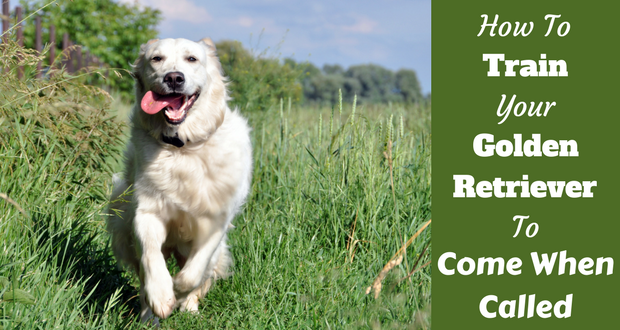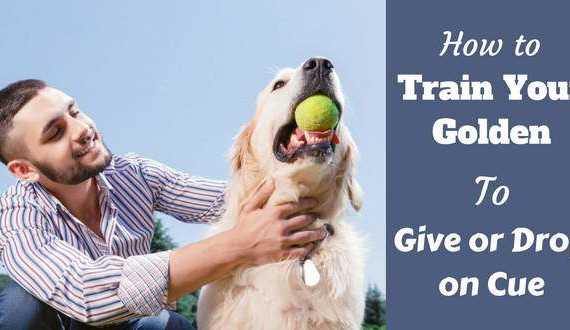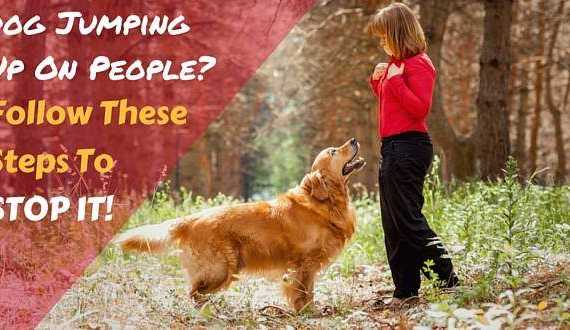Updated: August 1st, 2022

You know what’s one of the best things about having a close friend? When you need them, they come when you call them, no matter what they’re doing. They just drop it and hustle on over.
Well, the same should be true about “man’s best friend”, too! One of the most vital (and rewarding!) commands you can teach your Golden is “come.” If you’re having trouble making this one stick, or if you’re just starting your journey of obedience training, you’ve come to the right place.
Why is “come” an Important Command?
Of course Golden Retrievers are capable of learning a great many tricks and commands. Many of them are just for fun and enrichment. Some are a matter of convenience for you, the owner. But there are a select few that are absolutely vital to a good relationship with your dog. Coming on command is one of those.
Naturally, it’s satisfying to call your dog and have him race over to see you (or trot enthusiastically, if it’s a little older or chubbier). That wonderful face coming to be with you – that’s what makes dog ownership so great!
There are also important health and safety aspects to this command. A dog that responds well to “come” will come to you even if it doesn’t really want to. Why is this important?
Imagine you’re walking your Golden and something catches its attention, like a squirrel, or another dog. Suddenly it lunges forward and yanks the leash from your hand! You want your dog to come back to you immediately before it gets into or cause trouble.
Some other examples include:
- Running out the door unexpectedly
- Something dangerous spills on the floor
- Getting too friendly with a non-dog person
For so many reasons, “come” should be one of the first commands your Retriever learns.
When should I start teaching my dog to come?
The best time to start training your dog to come is when it’s a puppy. A puppy’s natural inclination is to follow you wherever you go, so why not take advantage of that?
The funny thing is, your puppy may be so attached to you, you might need someone else to hold it back while you move far enough away to have it come!
Priming your Golden Retriever for Successful Training
One of the main reasons a dog may hesitate to come when you call is because it’s doing something fun off-leash. It knows that you’re about to put on the leash and then the fun is over. The solution to this is simple: have fun with your dog while it’s on the leash.
By running around and playing and exploring neat places with your dog on a leash, it will associate good feelings with the leash, and understand that being with you doesn’t always mean the fun is about to stop. Therefore, being told to “come” when it is playing off-leash won’t be an automatic guarantee that playtime is over.
Be sure to keep up this behavior so your dog won’t associate the leash with packing up and going home.
You should also try to avoid using “come” as a command when something the dog finds objectionable is about to happen.
If your Golden learns that sometimes “come” leads to punishment for being bad, nail trimming, medicine, or anything it doesn’t like, it’s going to be understandably reluctant to stop doing something fun to see what you want. You’re better off going to get your dog and bringing it where you need it to be for activities like these.
Starting at the Beginning
The easiest place to begin training your dog to come is in your own home. This is the environment you can best control and with which your dog is most familiar. That should keep distractions to a minimum, and allow your Golden to focus on you.
It may be possible, and desirable to start with very informal training. As I said earlier, your puppy is probably your second shadow at this stage in its life. Take advantage of your ‘animal magnetism’ by telling your puppy to “come” when it’s already doing it anyway.
By doing so, you’ll get the dog used to the command word. Offer praise when it reaches you, just as you would in a formal session. After a while, when you are less of a novelty to your puppy, it will be well prepped for the next stage.
Basic Training
Start simple: have your dog sit, and back away from it. Have someone hold it in place if it won’t stay still. With a treat in hand (though an enthusiastic Golden puppy may not require a treat, it’s good to establish training protocols early), crouch down low and ask the puppy to “come” in a friendly and happy voice while holding the treat out where it’s visible.
When your dog starts coming your way, which it almost certainly will, offer lots of positive reinforcement and praise. Tell him or her she’s a good girl or boy until the treat is taken. If something distracts it along the way, cease offering praise, until it’s heading back in your direction.
Once this exercise has been successfully completed, release your pup to go about it’s own business for a short time. Repeat the process while it’s still fresh in the dog’s mind. After several successes, you may wish to phase out treats, or only offer them for an exceptional execution of the command.
Taking it Outside
For many dogs, concentrating on their owner’s commands becomes increasingly difficult when they’re outside. There are just so many wonderful distractions in the great outdoors!
Of course, you as the owner need your dog to respond to your commands outside just as well, if not better, than it does indoors. There are more possibilities for trouble outside, including interactions with unfriendly dogs, wild animals, and traffic.
Leash training is probably the best way to teach your dog to come: not only does it encourage good leash etiquette, but it also allows you to limit the dog’s movement if necessary.
Short Leash Training
The place you want to begin leash training is in your own backyard. This is a familiar environment for your dog, and a controlled one. There are probably just enough distractions to make for effective training, but no real hazards, either.
- Step 1: Attach a leash to your Golden’s collar. Use a standard length walking leash; about six feet will do.
- Step 2: Hold the end of the leash, give the “come” command and then begin quickly moving backward.
- Step 3: Continue moving backwards until your dog catches up to you. You can control how long this takes, but don’t draw it out too long.
- Step 4: When your dog does reach you, offer short, but enthusiastic praise.
- Step 5: Give a treat for a job well done.
Repeating these steps over and over will cement the lesson in your Retriever’s brain, and will help establish good leash skills. Your dog will learn that watching what you are doing is part of a good walk, rather than your dog leading you where it wishes.
Long Line Training
Once your dog seems to have mastered the command on a short leash, it’s time for the next step. A long line, cord or retractable leash allows your dog more freedom to move around, which increases the challenge level for the command training.
You’ll want to use a leash about between 20 to 30 feet in length. If that’s too long for your yard, see if you have a friend or relative with a larger yard that will let you train there. Failing that, try and find a secluded place away from too many other people and animals. (Pro tip: fenced in public tennis courts are great places to train when the nets are put away for the season!)
- Step 1: Attach the long leash to the collar.
- Step 2: Ask an assistant (Step 1 should probably have been: find an assistant) to stand to the rear of your Golden and hold him in place with his or her hands securely around the dog’s chest.
- Step 3: Show the dog a treat. Hold it right in front of the dog’s nose, but not quite close enough for it to be taken. Say things like, “what’s this?” or “I’ve got a treat!” in an excited voice to get your dog geared up.
- Step 4: Run a short distance away and give the “come” command. Offer encouragement if you need to, but do not say the command again. Your dog needs to know it has just one chance to get it right!
- Step 5: Offer short and enthusiastic praise when your dog gets to you.
- Step 6: Give the dog its well-earned treat.
As with all training, the key to mastering a command is repetition. With the long leash, however, repeated efforts should be made at increasingly greater distances. The goal is to be able to have your dog come the entire length of the leash without turning away.
Turn up the Difficulty
When the long leash training appears to be nearly perfected, try making things even more difficult by introducing distractions. Why would you intentionally complicate training by trying to distract your dog?
The ultimate goal of teaching your dog to come on command is to be able to have it respond to you no matter what the circumstances are. To get there, you’ll need to offer training as close to real world situations as possible.
Sounds a bit like the military, doesn’t it? That’s actually not a bad way to look at it: your dog is a friend, playmate, and beloved part of the family, but when an order is given, it needs to react like a good soldier!
Continue to do long leash training, but now use your assistant (who also deserves a reward!) to act as a distraction. Have him or her play with a ball, or other toy within the dog’s field of vision. If you know someone with a well-trained dog, introduce it into the mix.
These extra distractions may be too much for your dog at first, but persevere and soon you’ll both be well on your way to off-leash training.
But Wait, There’s More!
Before you get there, though, you may wish to try long leash training at the dog park, if there’s one in your vicinity, or any other place where dogs are allowed to run free. If there isn’t, or you don’t intend to frequent one, by all means skip ahead to the next step.
But if you do plan on visiting spots like this, training is well advised before simply letting your dog run free. (I’ve done this, in my naiveté: learn from my mistake!) If your Golden can obey the command repeatedly while visiting the doggy equivalent of the Magic Kingdom, you’re now approaching 100 percent mastery.
Off-leash Training: The Home Game
Just because your Golden is now proficient at coming on command on a leash, that doesn’t mean the same results will follow with no leash attached.
Your dog has quickly learned that when it’s not on a leash, it has complete autonomy. Think about it: it wanders around the house all day (except when crated), and probably gets to go out and do its business without a leash, too, and perhaps enjoy some free time exploring the yard.
All this means it may not feel the same level of compulsion to obey your command off-leash as it does when tethered. Clearly, that has to change.
Start off-leash training of the “come” command in the confines of your own yard. When your dog is running free, that’s when it’s most vulnerable, so you want to keep risk elements to a minimum.
Essentially, you’re following the same steps as you did with the long leash, except, obviously, there’s no leash. It’s that simple!
If your dog seems to be losing its focus, it may be necessary to regress a little bit. Take a half step back (figuratively) and try using a very light line, such as a length of thin nylon cord. This will give you some control, but not take you right back to the weight of a long leash.
Back to the Park
Now the ultimate test: off-leash at the park. If your Golden has mastered every other level of the training, you should be ready. Don’t just let your dog take off into the crowd immediately, however. Repeat your training exercises until you are satisfied with the response.
Once your dog is allowed to mingle, call it back on occasion, just for a check-in. By doing so, praising it, and then releasing it again, you are reinforcing that responding to a command to come doesn’t mean the party is over.
Advanced Variations
To keep your dog engaged and interested, it can be good to mix things up on occasion.
While learning to come on command in the house, try going to another room before giving the command. Your dog will enjoy the game of trying to find you, and you’ll learn how well the dog behaves when you’re not in its sight. Gradually try moving further and further away as your dog gets better at the game.
You can try this outside, too. Hide behind a tree, or shed and make your dog find you. Make sure you’re extra excited when you’re reunited, and take a bit of time to engage in some boisterous play before going another round.
Troubleshooting and Training Tips
No training process is ever completely linear, so here are some tips to help you with any hurdles you and your Retriever may need to overcome.
Take your Time
Rome wasn’t built in a day, and Rover wasn’t trained in one, either. Learning to come generally starts very young, when a puppy hasn’t learned much else. Every dog is different, and it is impossible to determine at the outset how long it will take to nail this command each and every time. Be patient, and your dog will learn at its own pace. Don’t worry: you’ll get there!
Hold Back the Goodies
A valuable tip to encourage a dog that doesn’t come immediately is to withhold the treat. If your dog is wandering away when it should be coming, and there’s no leash to correct it with, you’ll need to get its attention and repeat the command.
Offer praise when you dog does come, and let it see the treat, but do not give it. Only give the treat when the command is executed without hesitation. Your dog will quickly learn to come straight away if it wants a tasty reward.
Never Punish Failure
A lot is riding on this command; it may truly be the most important command of all. That being the case, it is only natural if you get frustrated occasionally if your Golden isn’t responding.
Draw on all your inner reserves of patience and try again. The LAST thing you should do is get angry at your dog if it doesn’t come when called. Why?
Well, if you got scolded when you went up to someone who called you, would you be likely to come willingly the next time? Being angry at your dog is a guaranteed way to make sure it thinks twice before answering your summons.
Don’t Unwittingly Start a Game
If your dog isn’t coming when you ask it to, you may be tempted to move in closer. Perhaps making the distance a little shorter might encourage him or her to come?
Unfortunately, the opposite may be true. As you approach your dog, it may decide to move further away. And if you keep moving in, well, clearly you’ve started a fun game of “tag” that might escalate into “catch me if you can” at any moment.
Your dog is far more likely to come to you if you move a little further away. This movement should lure it in. If it doesn’t, just wave the treat around a little and you will probably get the desired response.
Reinforce the Training at Random
In the early days of teaching the “come” command, it may be helpful to try some impromptu sessions. Instead of a standard training exercise, try to get your dog to come for a reason other than a proffered treat.
Try asking your dog to come, and then pull out the leash for a walk. If it responds to the command, great! Slip on the leash and enjoy a nice walk!
If there’s no response, though, show the leash but then put it away. If your dog likes a walk, it will certainly take note of the fact the leash came out, but no walk happened.
A little later, try the same thing again. It won’t take long for the connection to be made between coming on command and something good happening. If your dog likes to ride in the car, you can do the same thing with jingling car keys.
Don’t Reward Bad Behaviour
Being allowed off-leash somewhere other than the dog’s own home or yard is the ultimate reward for coming on command. However, if your dog is unable to perform as well off-leash as on, you’ll need to revoke its privileges temporarily.
Should your dog not come immediately when called at the park, take steps to get it back on a leash. Though you may be tempted to allow a second chance, do not let it off the leash again until you’ve had some time to retrain at home.
Once you’re back to full obedience, then you can go back to the fun again. By allowing your dog the same level of freedom even when it doesn’t come on command, you’re teaching it that it can get away with being bad and still get to have fun.
The Eyes Have it
One of the best tips for successful training is also one of the simplest. Engage with your dog as often as you can. Even something as simple as smiling or saying “hi” in a friendly voice when your dog catches your eye can be a powerful motivator.
If it sees you as a pleasant person to be around, and you’ve built a bond between the two of you, your dog will be that much more likely to come when you call.
Concluding Thoughts
If your dog masters just one command, let it be this one. There really is no command more vital to the well-being and safety of your Golden Retriever than “come.”
Of course you’ll want to teach your dog more than just this command, but mastering this one can help with many others. Certainly there’s little point in trying to teach your dog “sit” or “stay” if you can’t even get it to come to you!
And how great will it feel to be able to take your dog to the park, watch it frolic and play with its friends, and then have it leave the crowd behind to join you at your side? That, my good friends, is what doggie companionship is all about.




1 Comment
Peggy Kurzawinski
I have been using loving discipline with our little Bella she is 5 months old the most important command I want her to learn is come I have been rewarding her with treats love and affection. I’ve been training her off leash with treats since she was a puppy to come. we have two acres we are retired so I’ve been doing the come command consistently but as soon as we go out in the yard with distractions she just looks at me and runs the other way sometimes she just sits down and looks at me. I’m always excited when I say come. I never scold her when she does not come but it’s starting to frustrate me when she acts like she doesn’t always understand Come? Now she takes off and runs the other way like it’s a game Golden are the best. Thank you